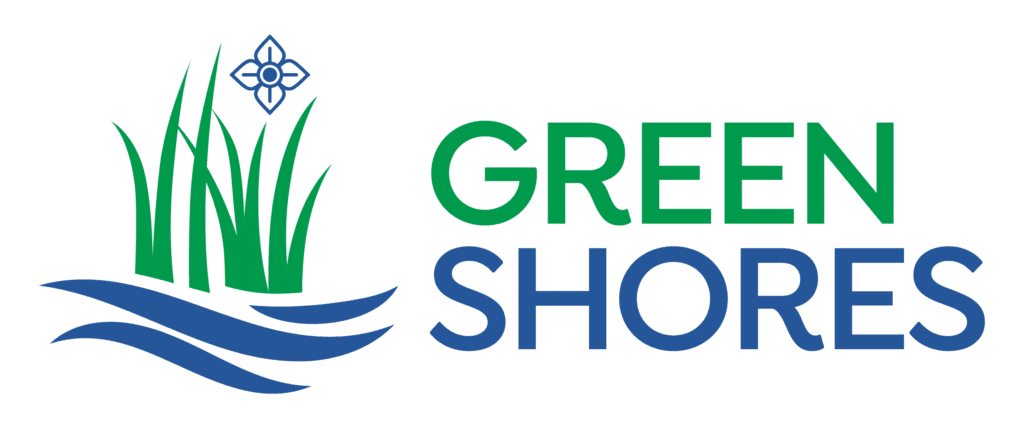
Green Shores® is a program of the non-profit Stewardship Centre for British Columbia (SCBC) that encourages the use of nature-based solutions to promote healthy shore environments which provide economic, environmental, and social benefits for coastal communities.
Green Shores offers a framework of best practices, training, and technical support to property owners interested in applying nature-based solutions on their property.
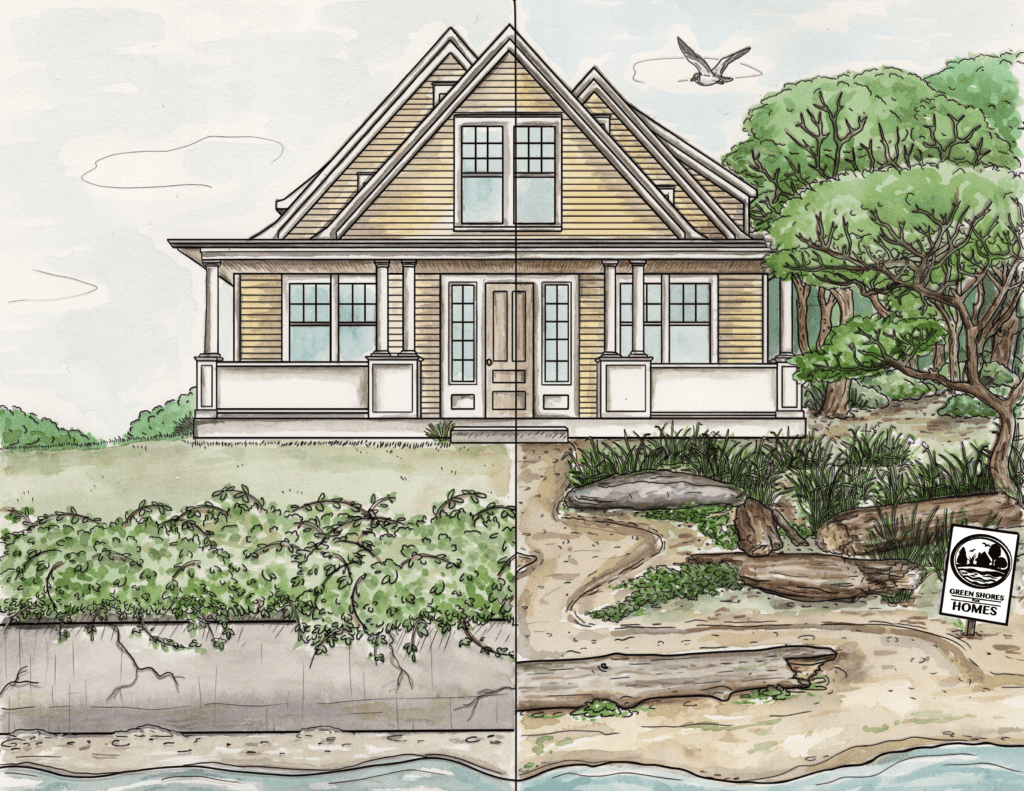
Green Shores is based on nature-based solutions for the shoreline that benefit both the homeowner and the terrestrial and aquatic environments.
By working with natural shoreline features such as riparian vegetation, large woody debris, shoreline materials (sand, cobble, and gravels) and natural processes (for example, sediment transport), Green Shores designs protect and make shoreline properties more resilient. Resiliency is key with the threats of climate change: sea level rise, storm surge, erosion and flooding. while also improving access to the shoreline and enhancing the aesthetic value of shoreline properties.
Learn more about nature-based solutions for the shoreline and get advice on the process of working with the Green Shores team and achieving certification.
Green Shores projects are based on four important principles that benefit both the homeowner and the environment:
With changing climate and increased use and development of shorelines, ecosystem-based approaches, like Green Shores for shoreline management, are increasingly important and valuable to shoreline homeowners and coastal communities. The Stewardship Centre for BC provides guidelines and support to homeowners interested in applying Green Shores nature-based solutions on their properties.
Conventional hard armour creates a barrier between the upland and riparian areas and prevents the essential transport of sediment along the shoreline. Green Shores nature-based solutions work with nature to allow for the natural movement of sediment while reducing the energy and impact of incoming waves, including the potential of erosion and flooding. In addition, Green Shores designs support biodiversity and habitat connectivity in all directions on the shoreline.

Conventional hard armour creates a barrier between the upland and riparian areas and prevents the essential transport of sediment along the shoreline. Rigid hard armour can also increase wave action and can be accompanied by erosion, threatening shoreline infrastructure.
Photo credit: District of West Vancouver
Green Shores nature-based solutions work with nature to allow for the natural movement of sediment while reducing the energy and impact of incoming waves, including the potential of erosion and flooding. In addition, Green Shores designs support biodiversity and habitat connectivity in all directions on the shoreline.
Green Shores nature-based solutions help lessen the impact of waves on the shore, support sediment movement and enhance floodwater infiltration thus protecting homeowners from floods and erosion. Photo of the Green Shores for Homes site in Qualicum Beach, credit: Kelly Loch.
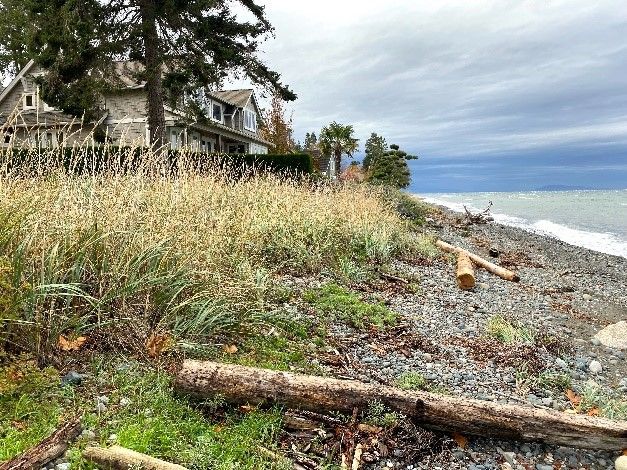
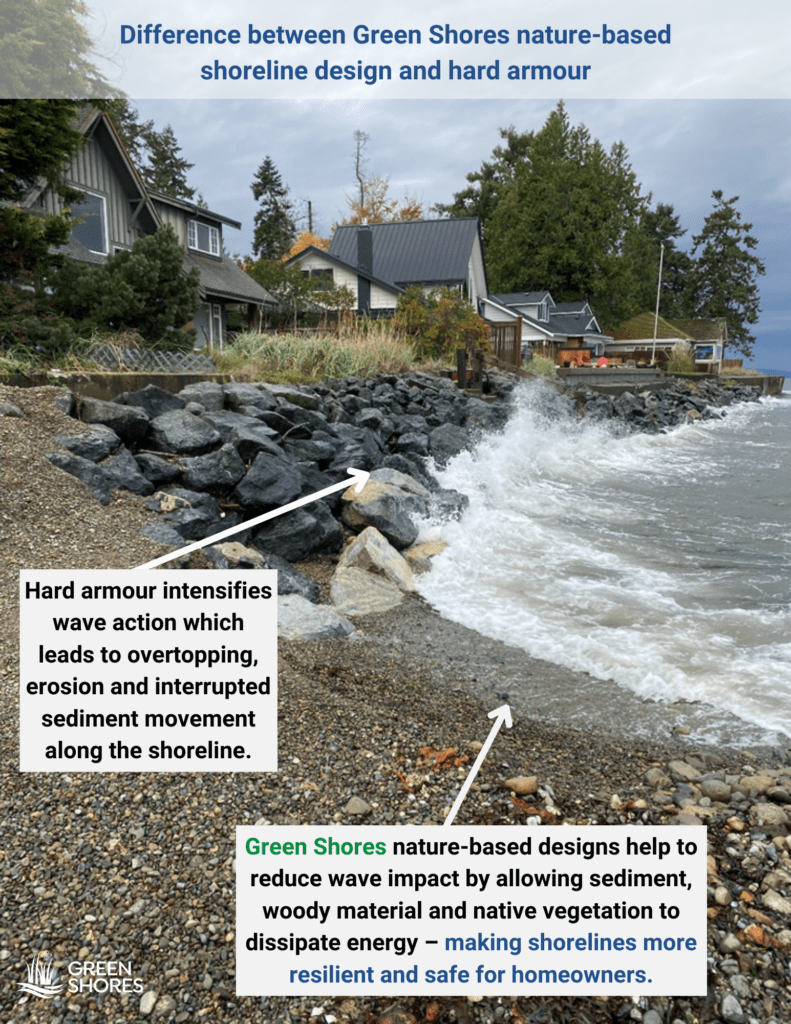
Hard armour that includes riprap, concrete and wooden walls, is one of the most expensive practices that can be done on the shoreline, considering the cost of required materials and labour (Côté and Domanski 2019).
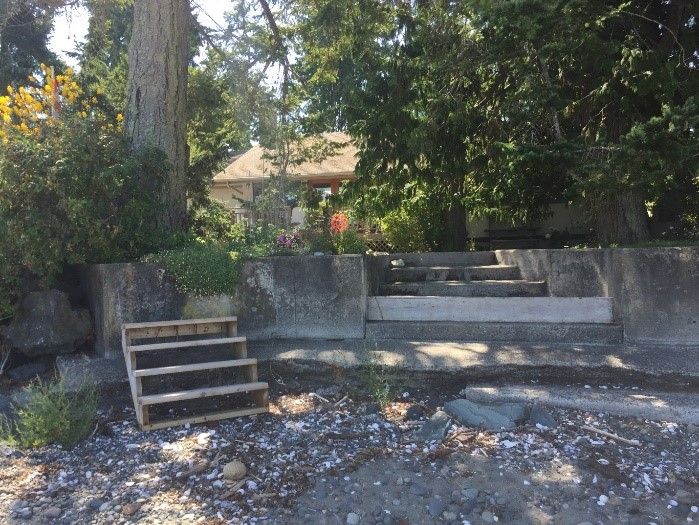
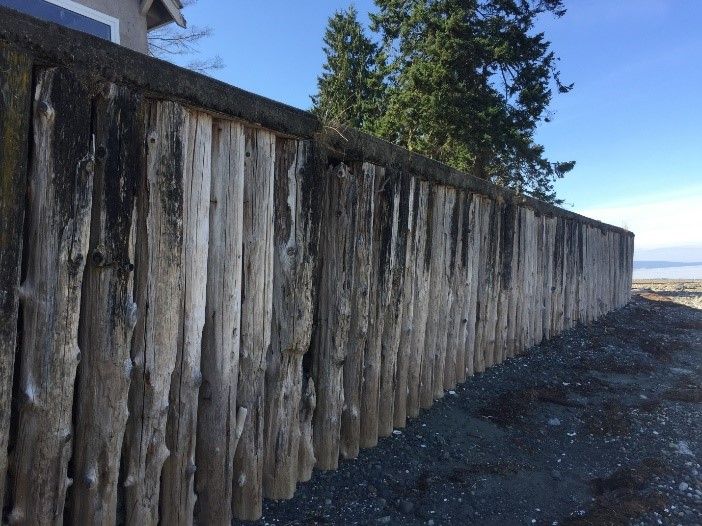
The least costly option is sustaining a healthy natural shoreline. It has been calculated that the average cost for hard armour installations is between $50,000-$60,000 USD per 100ft piece of shoreline; in comparison, soft shore installation is about half of that price, between $25-30,000 USD (Côté and Domanski 2019). Other estimates also demonstrate that hard armour is consistently more expensive than nature-based approaches, see the estimates provided in the table below.
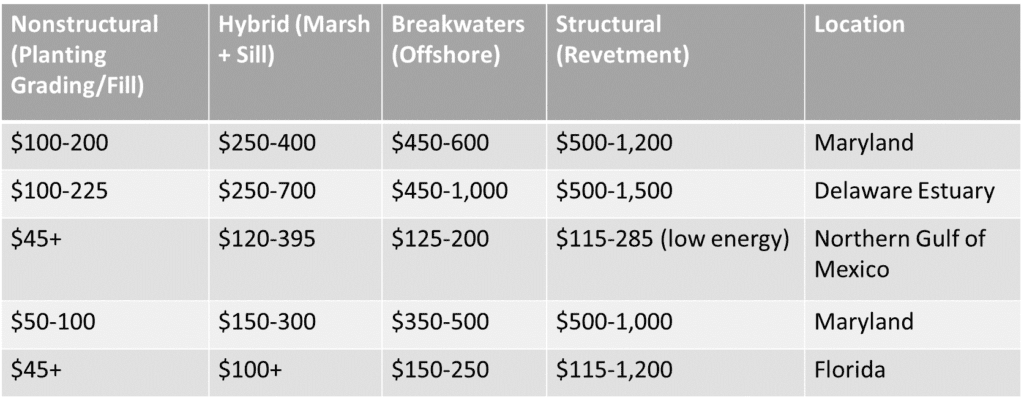
Of course, all shoreline projects, including Green Shores, have associated costs such as permitting, consulting, design, engineering, biological studies and cultural investigations, as well as other expenses like materials, equipment, and labour (Côté and Domanski 2019). Homeowners are responsible for hiring consultants as needed, obtaining required permits, purchasing native vegetation and scheduling machine work on site if required by the project design. However, once installed, nature-based shorelines are adaptable to changing environment and extreme weather events, requiring minimum maintenance and helping save costs on flood control and flood damage, which can cost homeowners tens of thousands of dollars in repair (Moudark et al. 2018).
Nature-based shoreline solutions also provide a return on investments and economic benefit – both now and into the future. For example, property value with a natural shoreline may be increased due to the increased aesthetic value of the property, improved shoreline access, and enhanced ecosystem services like flood control, air, climate and water regulation, and pollution management (Eyzaguirre et al. 2020; Côté and Domanski 2019). In 2020, a two-year socio-economic assessment of the Green Shores for Shoreline Development program revealed that the nature-based Green Shores program provides a benefit-cost ratio of 7:1, such that each $1 invested in a Green Shores for Shoreline Development project generates $7 in a multitude of benefits including social welfare in BC (Eyzaguirre et al. 2020). Further, investments made as part of the Green Shores program have made noteworthy contributions to the BC economy by, for example, supporting 74 to 83 jobs (Eyzaguirre et al. 2020)
Green Shores nature-based designs also support biodiversity by creating and protecting habitat for both aquatic and terrestrial life, including amphibians, invertebrates, fish, birds, mammals, insects, and other wildlife, and enhance habitat with appropriate sediment for important intertidal species such as forage fish. Planting vegetation such as native shrubs and trees provides shade and temperature regulation during the summer and dead leaf matter and insects that drop from overhanging vegetation becomes a food source for invertebrates that sustain healthy soils and riparian and intertidal communities. Sediment, large woody debris and rocks provide spawning and foraging habitats for fish and migratory birds along the shoreline. In contrast, sea walls reduce the quality and quantity of habitat (Gittman et al. 2016).
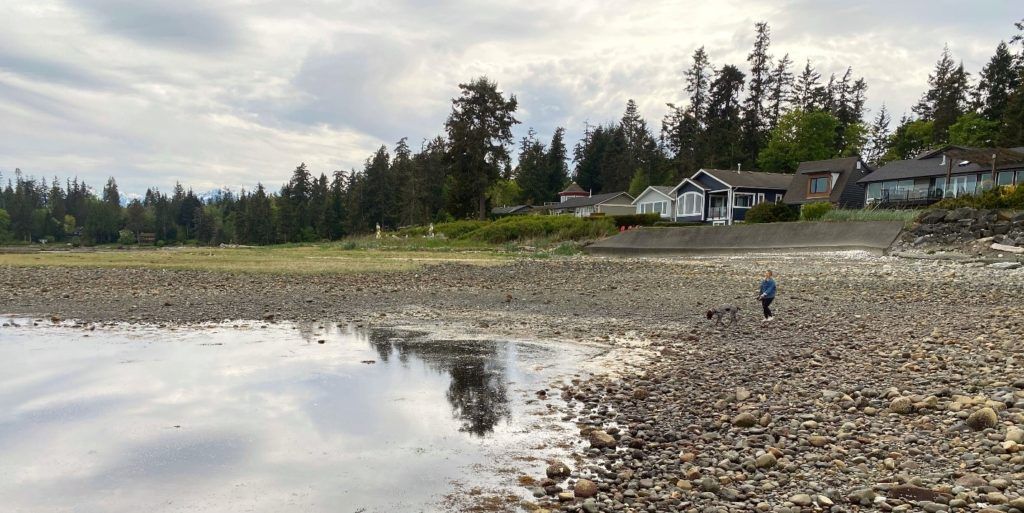
In addition, healthy shoreline ecosystems provide recreational opportunities, aesthetic value, and spiritual and heritage values for adjacent properties, contributing to increased cultural significance and use of the shoreline (Eyzaguirre et al., 2020, Eyquem 2021). Natural shorelines are the source of raw materials that include food, water and medicine (Eyzaguirre et al., 2020). This is particularly important for direct consumption and future sustainable uses of materials found along natural shorelines.
Photo credit: Kelly Loch
Green Shores assisted with coordinating a shoreline restoration project on a private property next to the City of Nanaimo's Piper’s Lagoon Waterfront Park. The site is located within an intact Garry Oak ecosystem and adjacent to a protected low-energy tidal flat, which is frequented by waterfowl and shorebirds. The main objective of the project was to remove the armouring and restore native riparian vegetation for a supportive and functioning foreshore environment.
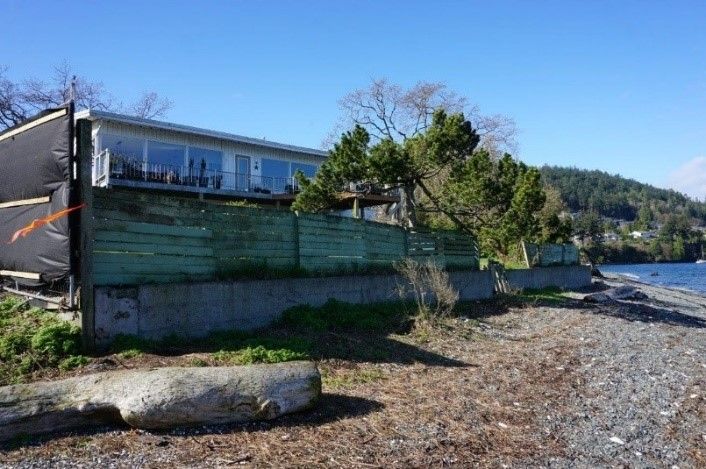
Prior to the restoration, there was an old concrete bulkhead with a fence along its top. This armouring significantly reduced shoreline function by interrupting the movement of materials and fauna between the upper and lower slope, and by impacting sediment transport along the shoreline. High tides would interface with the bulkhead, creating scouring along its edge.
Photo credit: Kelly Loch
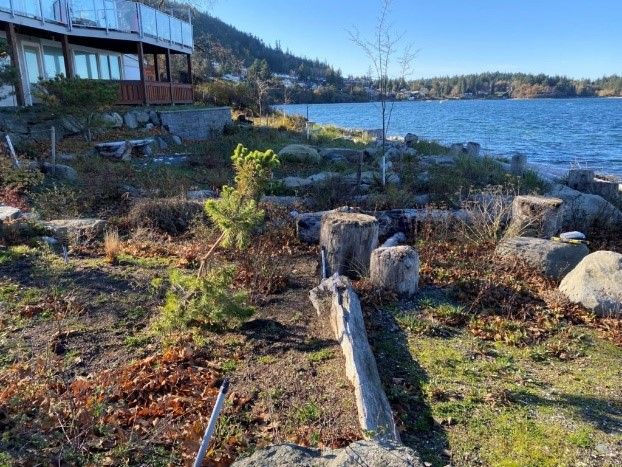
Tidal function was fully restored through the removal of the bulkhead. The added woody and rocky materials are creating microhabitats and dissipating wave energy for a more complex and resilient riparian zone. The native plants are helping to stabilize the shoreline and control erosion. The end result is a restoration of approximately 458 m2 of riparian habitat and a beautiful shoreline property!
Photo credit: Kelly Loch
To find out more about this site, see this link. If you’d like to see more case studies, you can find more here and here.
Would you like to do something similar on your property? See how you can enlist Green Shores help to achieve it.
Green Shores Downloadable Guides and Resources
Green Shores Webinars
References for the information contained within this post:
Côté, J. and Domanski, A. (2019). Benefit Cost Analysis of Shore Friendly Practices in Island County. Island County Department of Natural Resources.
Eyquem, J. L. (2021). Rising Seas and Shifting Sands: Combining Natural and Grey Infrastructure to Protect Canada’s Coastal Communities. Intact Centre on Climate Adaptation, University of Waterloo.
Eyzaguirre, J., Boyd, R., Prescott, S., Morton, C., Nelitz, M. and Litt, A. (2020). Green Shores 2020: Impact, Value and Lessons Learned, Final Project Report. Prepared by ESSA Technologies Ltd. Prepared for the Stewardship Centre for British Columbia.
Gittman R , Scyphers S , Smith C , Neylan I , and Grabowski, J. (2016). Ecological Consequences of Shoreline Hardening: a Meta-analysis. BioScience 66(9): 763–73.
Moudrak, N , Feltmate, B , Venema, H , and Osman, H. (2018). Combating Canada’s Rising Flood Costs: Natural Infrastructure is an Underutilized Option. Prepared for Insurance Bureau of Canada Intact Centre on Climate Adaptation, University of Waterloo.
Restore America’s Estuaries. (2015). Living Shorelines: From Barriers to Opportunities. Arlington, VA.